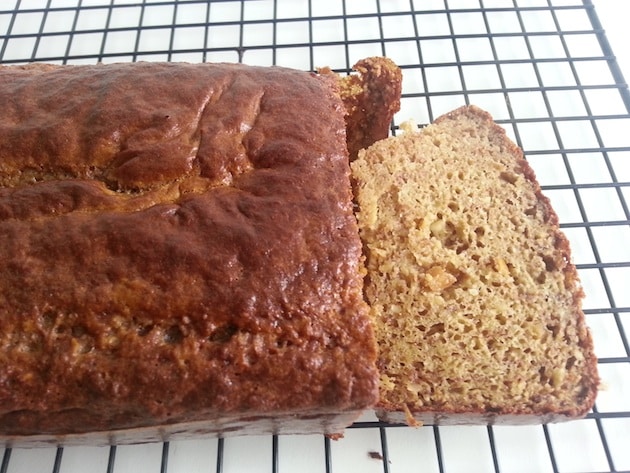Yesterday my wife, Lucy, decided to bake George Bryant’s famous Gluten Free Banana Bread.
This is a delicious recipe that can be used as a treat at anytime, and because it contains no gluten it’s much better for you.
As I’m sure you know Gluten can cause many serious health problems. For more on the problems with grains see my article here.
So as a result I always recommend that my clients avoid Gluten as much as possible.
OK, here’s what the Banana Bread looks like straight out of the oven:

Baking this delicious Banana Bread is very simple.
Here are the Ingredients you will need:
- Pinch Sea Salt
- 1/2 Cup Ground Almonds
- 1 Teaspoon Bicarbonate of Soda
- 1 Teaspoon Baking Power (Gluten Free)
- 4 Tablespoons Virgin Coconut Oil
- 1/2 Cup of Peanut Butter (not in image below)
- 4 Bananas
- 4 Eggs
- 1 Tablespoon Ground Cinnamon
- 2 Vanilla Pods (or Teaspoon of vanilla)

You will also need the following utensils:
- Mixing Bowl
- Over Proof Dish or Bread Tin
- Measuring Cups, Tablespoon and Teaspoon
- Masher

- Add the Bananas, Eggs, Peanut butter and Coconut oil into a mixing bowl and mash and mix well
- Next add in the Almond Flour, Cinnamon, Bicarbonate of Soda, Baking Powder, Vanilla and Sea Salt. Mix again.
- Rub your Oven Dish or Bread Tin with some Coconut Oil to avoid sticking
- Add the mixture to your Dish or Tin

- Bake the mixture in a Preheated Oven at 180 degrees or Gas Mark 4 for 40 minutes
- Remove from its tin and flip it onto a cooling tray (see photo 1)
Finally enjoy on its own or with butter…

Good luck, you are in for a real treat!
Have your tried this Banana Bread? If so let me know below…
















